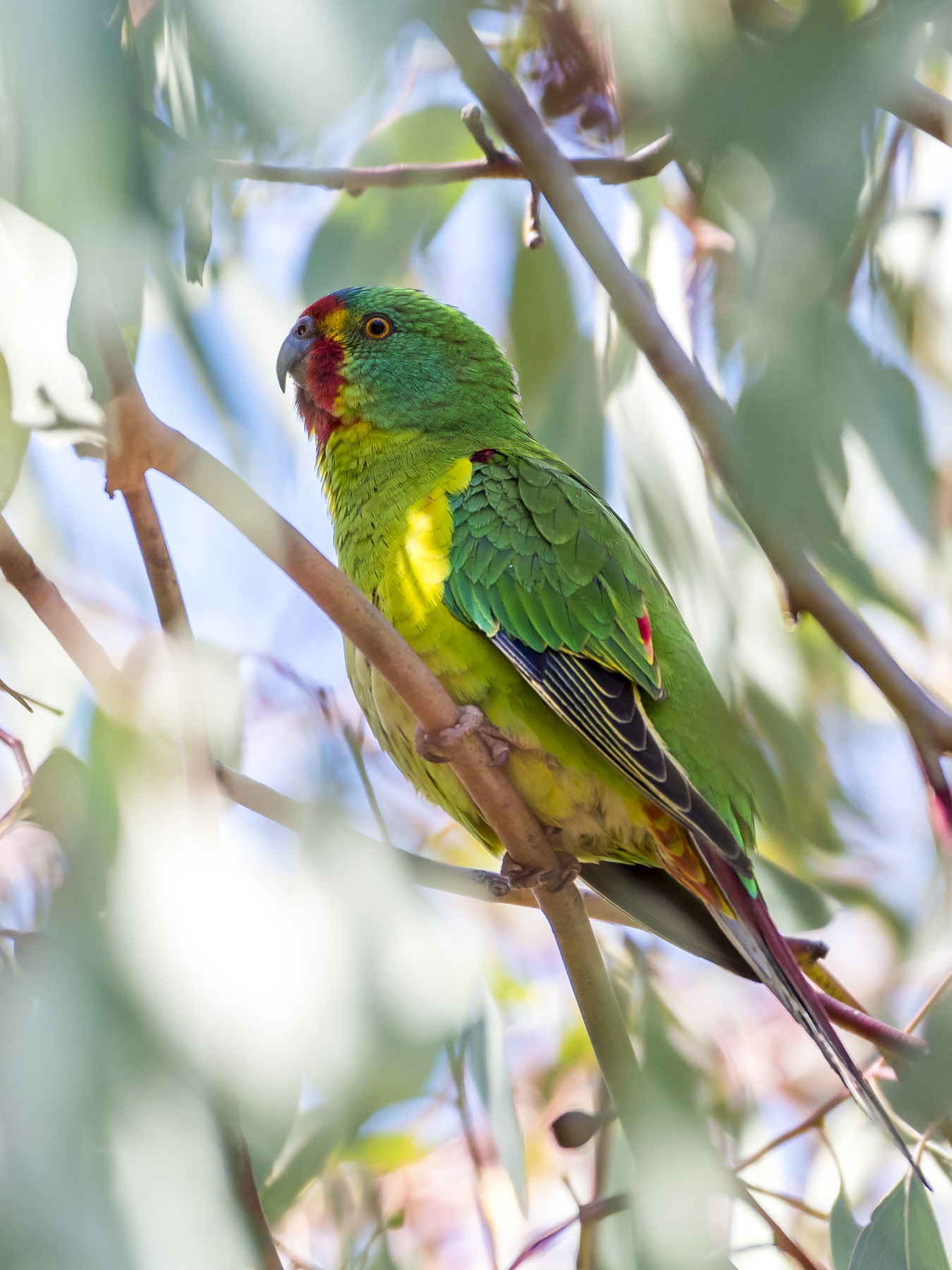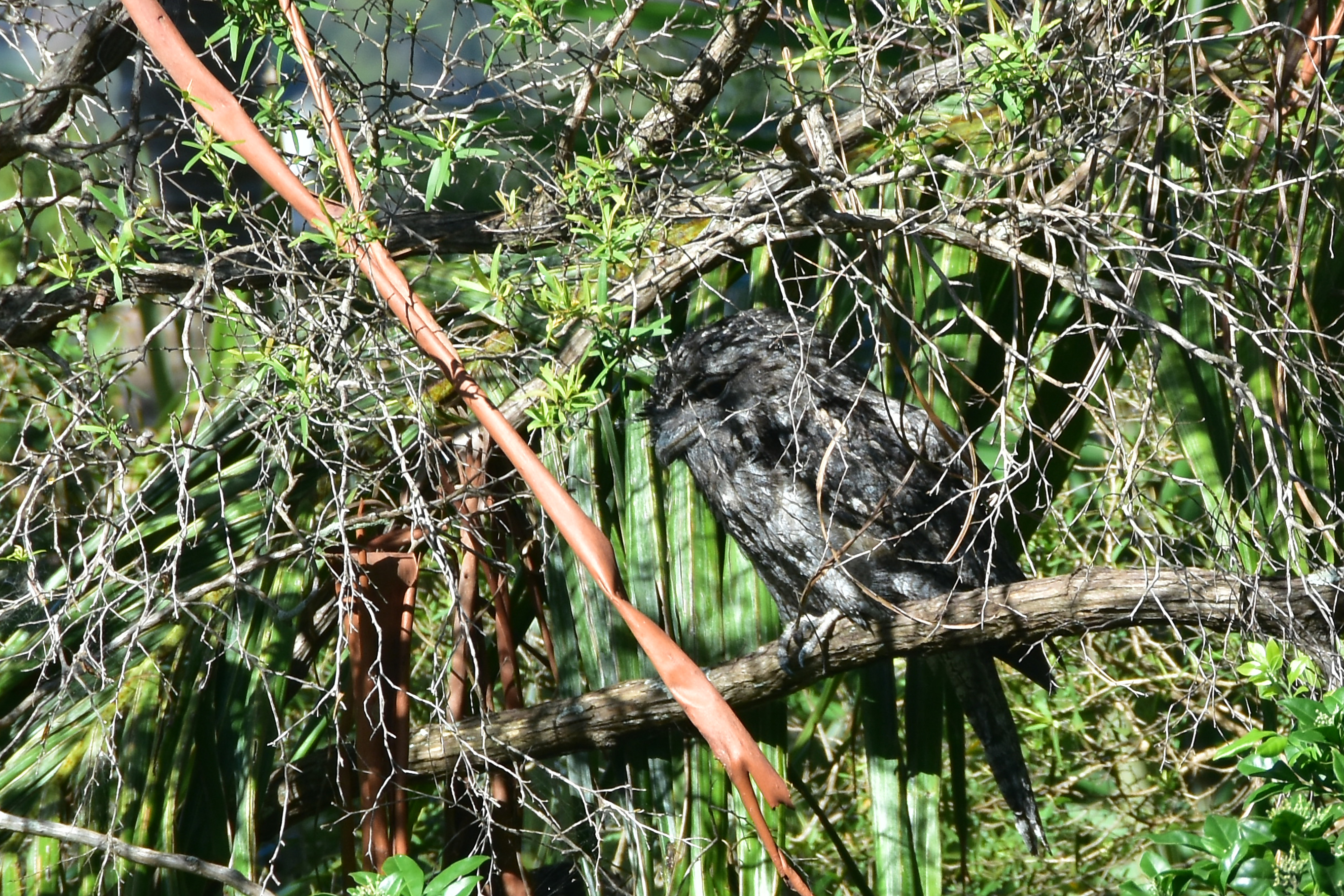Return of Australasian Figbird Pair: A Reason to Keep the trees - Aussie Bird Count 2023
Each Spring this pair of Australasian Figbirds(Sphecotheres vieilloti) returns to build a nest and make babies in the Norfolk pine alongside us. There is food in our garden for them and no cats, at least none that can get that high up.
Their fast chirrups and calls are a delightful and welcome annual return and they are listed in BirdLife Australia's 'Top 40 Bird Songs' which lists the most curious or distinctive bird calls in urban areas (mostly around Sydney).
Figbirds are part of a worldwide family that includes the orioles, of which Australia has two other members (the Yellow and Olive-backed Orioles). The Australasian figbird has a total length of 27.0–29.5 cm and a body mass of around 111 to 130 grams.
Males have bare, red skin around the eye, contrasting against a black crown and grey neck and throat. The remainder of the body is olive-green, except for a white under-tail area. There are two distinct colour forms of the males of this species. Males north of Proserpine in Queensland have a yellow front.
Females have grey skin around the eye and lack distinctive head markings. They are brown-green above and dull-white below, streaked with brown. Both sexes have a blackish bill.
The Figbird occurs across coastal regions of northern and eastern Australia from the Kimberley region in Western Australia around to the New South Wales/Victoria border. They live in rainforests and wet sclerophyll forests, but are often found in urban parks and gardens, particularly those with figs and other fruit-producing trees
Figbirds are commonly encountered in city parks that contain fig trees, and will often visit orchards and gardens that have leafy trees and berry-producing plants. Fruiting canopy trees, particularly figs, are essential components of the environment of Figbirds.
The nest is cup-shaped and built of vine tendrils and twigs. It is supported by its rim from the horizontal fork of an outer branch of the canopy, up to 20 m above the ground. Both males and females incubate the eggs and feed the young. The clutch of two to four eggs typically hatches after 16–17 days.
Unlike most orioles, Australasian figbirds are gregarious, often forming flocks of 20 to 40 birds during the nonbreeding season, and even breeding in small, loose colonies.
However, they are not the only birds that turn up from elsewhere during the end of September and beginning of October. BirdLife Australia advises birds to look out for in October, especially those returning in our Spring, are:
- Dollarbirds in south-eastern Australia
- Channel-billed Cuckoos to the Top End
- Flocks of White-browed and Masked Woodswallows in southern Australia
- Dollarbirds arriving back in the Kimberley Region of WA
- Oriental Pratincoles in northern Australia
- Return of Fork-tailed Swifts to northern Australia
- Black-faced Cuckoo-shrikes arriving back in Tasmania
- Migratory shorebirds returning to southern Australia
On Friday October 6 BirdLife Australia announced the Bird of the Year.
BirdLife Australia works with the Guardian to develop a list of birds, including some that are getting particular coverage to showcase conservation issues.
The competition kicked off on Monday 25 September with a lineup of 50 Australian native birds. The bottom five birds are eliminated at the end of each weekday, with everyone able to vote again in the next round each day. The final 10 birds were voted on on Thursday the 5th.
This year BirdLife Australia has announced, with a grand total of 11,171 votes, the Critically Endangered Swift Parrot is the winner of the 2023 BirdLife Australia X Guardian Australia Bird of the Year competition – the first time Swifties have taken out the title.
The much-loved Tawny Frogmouth once again finished in second place despite leading for much of the competition. With 10,729 votes, it’s the Tawny’s third time in a row as runner-up! In third place is the Endangered Gang-gang Cockatoo with 7,190 votes.
The Critically Endangered Swift Parrot is one of only three species of migratory parrots in the world.
Twice a year, these remarkable birds brave crossing one of the world’s most dangerous bodies of water – Bass Strait – as they migrate from their Tasmanian breeding grounds to the mainland to feed on flowering gums and lerp in south-eastern Australia, including in Pittwater according to listings compiled by Pittwater Council for our bush reserves and suburbs. They arrive in Tasmania during September and return to south-eastern Australia during March and April.
With fewer than 750 birds left in the wild, this years' winner is a win for threatened species everywhere.
But it’s also an important reminder of what we stand to lose. Sadly, Swifties are rushing towards extinction – threatened by habitat destruction and predation by introduced Sugar Gliders in Tasmania. Still, logging of their forest habitat continues in NSW and Tasmania – and experts predict that fewer than 100 birds will remain by 2031 if their current rate of decline continues.
“We are watching extinction in real time for the Swift Parrot.” ‒Samantha Vine, BirdLife Australia’s Head of Conservation and Science
Alongside the Regent Honeyeater, the Swift Parrot has long been the face of woodland bird conservation in south-eastern Australia – and for decades, BirdLife Australia has been working closely with this Critically Endangered species to help their population recover. They are dedicated to preventing their extinction – campaigning against logging in Swift Parrot habitat on both sides of Bass Strait, tracking their mainland movements, filling knowledge gaps critical to their conservation and more.
It's not just logging that's compounding the problem. Revelations on the same day, October 6, that Swift Parrots have been recorded near the Boggabri open cut coal mine in the Leard State Forest near Narrabri - the second year in a row the parrots have been detected by the mining company - has prompted calls for action from Environment Minister Tanya Plibersek.


Tawny in Kevin and Glenys Murray backyard. Photo: Kevin Murray
In this LGA 103 Tawny Frogmouths have been rescued and 29 released in the June 2020 to June 2021 period. Collisions with motor vehicles and ‘unsuitable environment’ are listed as the primary reasons for the birds coming into care. Disease, listed as an ‘internal parasite’ is also listed.
Tawny frogmouths will often perch at the sides of roads where streetlights attract moths. Another reason to slow down on our local roads.
The tawny frogmouth (Podargus strigoides) is a species of frogmouth native to the Australian mainland and Tasmania and found throughout. It is a big-headed, stocky bird, often mistaken for an owl, due to its nocturnal habits and similar colouring, and sometimes, at least archaically, referred to as mopoke, a name also used for the Australian boobook, the call of which is often confused with that of the tawny frogmouth.
Tawny frogmouths are carnivorous and are considered to be among Australia's most effective pest-control birds, as their diet consists largely of species regarded as vermin or pests in houses, farms, and gardens. The bulk of their diet is composed of large nocturnal insects, such as moths, as well as spiders, worms, slugs, and snails but also includes a variety of bugs, beetles, wasps, ants, centipedes, millipedes, and scorpions. Large numbers of invertebrates are consumed to make up sufficient biomass, as are reptiles and frogs, and birds.
The conservation status of tawny frogmouths is "least concern" due to their widespread distribution. However, a number of ongoing threats to the health of the population are known. Many bird and mammalian carnivores are known to prey upon the tawny frogmouth. Native birds, including ravens, butcherbirds, and currawongs, may attempt to steal the protein-rich eggs to feed their own young. Birds of prey such as hobbies and falcons, as well as rodents and tree-climbing snakes, also cause major damage to the clutches by taking eggs and nestlings. In subtropical areas where food is available throughout the year, tawny frogmouths sometimes start brooding earlier in winter to avoid the awakening of snakes after brumation. Since 1998, a cluster of cases of neurological disease has occurred in tawny frogmouths in the Sydney area, caused by the parasite Angiostrongylus cantonensis, a rat lungworm.
The great Aussie Bird Count takes place 16–22 October for 2023. You can get involved here: aussiebirdcount.org.au
_-NSW_-Australia-8.jpg?timestamp=1696659499462)
Two immature Gang-gangs at New Buildings, NSW, Australia: The male is on the left and the female on the right. Photo: David Cook Wildlife Photography
Info: BirdLife Australia
Australasian Figbirds photos: A J Guesdon, taken October 7, 2023